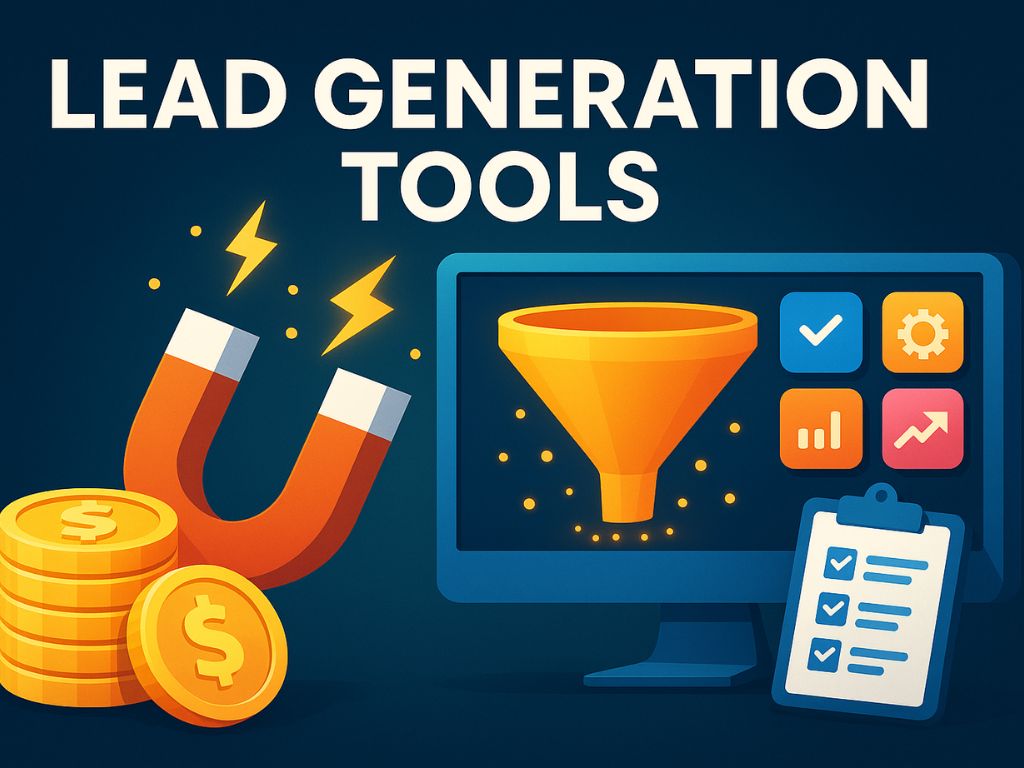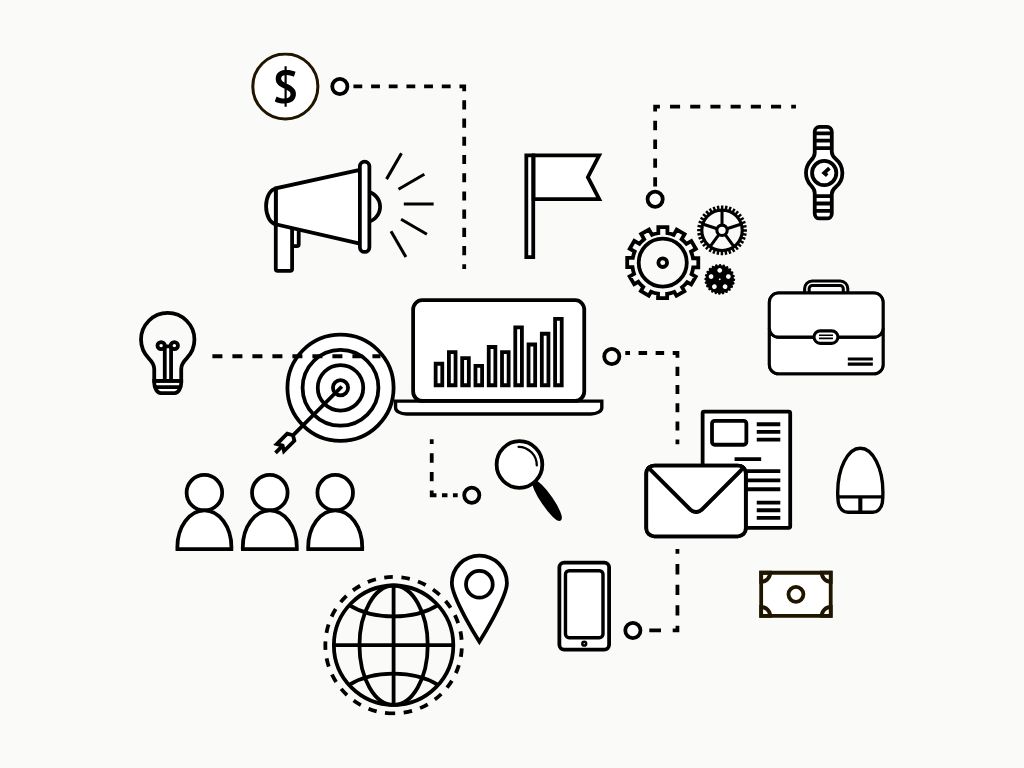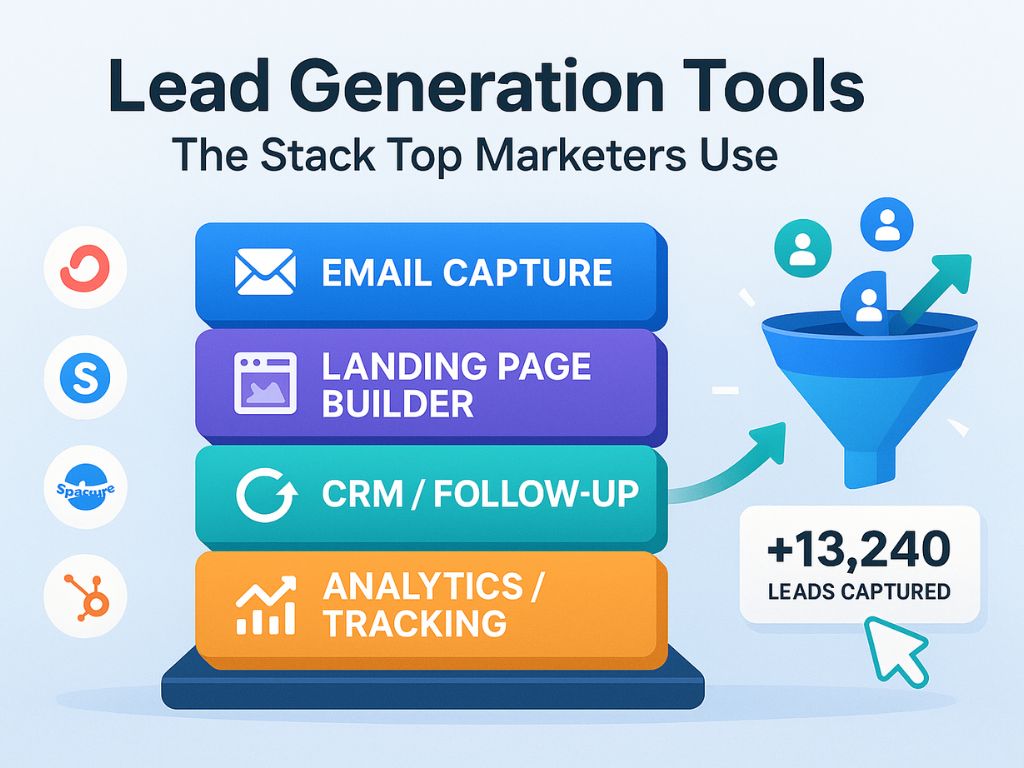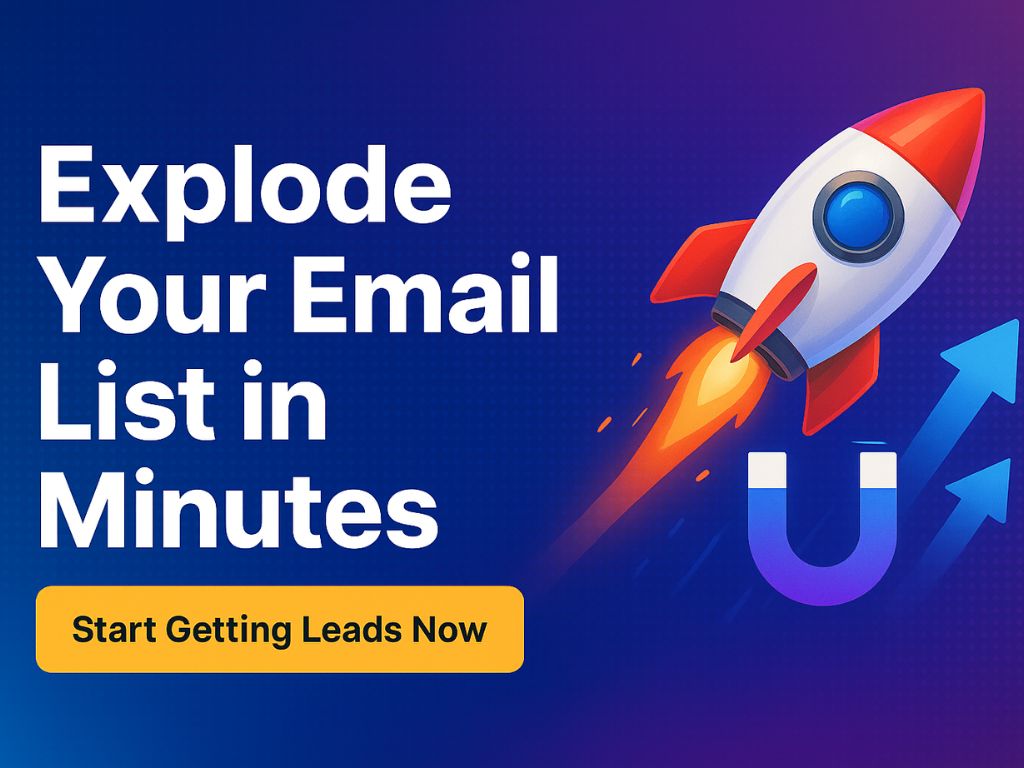Introduction
Every business, regardless of size or industry, relies on one essential process: turning attention into opportunity. Lead generation tools make that possible by capturing, tracking, and nurturing potential customers before they disappear into the noise of the internet. What once required manual outreach and spreadsheets now happens through connected systems that automate every stage of discovery and engagement.
For small businesses, marketers, coaches, and creators alike, these tools remove guesswork and deliver clarity on what drives real conversions. They integrate data, communication, and analytics into one workflow that transforms curiosity into measurable growth.
This article explores the best lead generation tools available in 2025, grouped by their purpose and strengths. By the end, you will know which categories fit your goals, how they work together, and what separates a good setup from a great one.
Key Takeaways
How Lead Generation Tools Power Modern Marketing
- Lead generation tools simplify how businesses capture and manage new prospects.
- CRMs remain the foundation for organizing and tracking every interaction.
- Marketing automation platforms personalize engagement at scale.
- Data enrichment tools improve accuracy and reveal deeper insights about leads.
- SEO and content tools attract qualified visitors through organic discovery.
- Landing page builders turn traffic into measurable conversions.
- The best results come from integration — uniting all tools into one seamless, data-driven system.

What are lead generation tools and how do they work?
Lead generation tools are digital systems that help businesses attract, capture, and organize potential customers. Their purpose is to simplify the process of turning interest into actionable opportunities by collecting data, qualifying prospects, and guiding them toward conversion.
These tools operate across multiple stages of the marketing funnel. Some attract visitors through search and content. Others capture information through forms, chatbots, or sign-ups. Once collected, the data flows into a centralized system, such as a CRM or automation platform, where it can be analyzed and nurtured over time.
A strong lead generation tool does more than gather emails. It provides visibility into who the lead is, what they engage with, and when they are most likely to respond. This insight allows teams to prioritize outreach and personalize follow-ups without guesswork.
Modern platforms use automation, AI, and data enrichment to make this process faster and more precise. They integrate with marketing and sales systems to ensure that no potential customer slips through the cracks.
According to HubSpot, 61% of marketers consider generating high-quality leads their biggest challenge.

Core categories of lead generation tools
Different lead generation tools serve different roles, but together they create a connected system that captures, qualifies, and converts potential customers. Understanding these categories helps you choose tools that fit your workflow instead of crowding your stack with overlapping features.
1. CRM (Customer Relationship Management) systems
A CRM is the backbone of every lead generation strategy. It stores contact information, tracks interactions, and manages communication history across email, chat, and calls. For businesses that handle multiple leads daily, this centralization prevents lost opportunities and ensures timely follow-ups.
Popular options such as HubSpot CRM, Pipedrive, Zoho CRM, and Salesforce Essentials make it easy to monitor where each prospect stands in the funnel. The best systems integrate with email marketing, automation, and analytics platforms, creating a single source of truth for all customer data.
CRMs are essential because they bridge marketing and sales, providing the insight needed to convert interest into revenue.
2. Marketing automation platforms
Marketing automation tools handle repetitive but critical tasks like email campaigns, lead scoring, and follow-up reminders. They ensure that every lead receives relevant information at the right moment, nurturing relationships automatically while saving hours of manual work.
Platforms such as ActiveCampaign, Mailchimp, ConvertKit, and GetResponse help personalize communication through dynamic content, segmentation, and behavior tracking. When used correctly, automation feels natural to the recipient and strengthens brand trust.
Automation is most effective when paired with a CRM, creating a feedback loop between lead data and engagement insights.
3. Data enrichment and prospecting tools
Accurate, complete data defines the quality of your leads. Data enrichment and prospecting tools enhance raw contact details by adding information such as company size, industry, role, and intent signals. This allows teams to focus outreach on prospects with genuine potential.
Examples include Clearbit, Apollo, ZoomInfo, and Hunter.io. These platforms pull verified information from large databases to improve targeting precision. Integrated with CRMs or automation systems, they automatically update and segment contact lists for cleaner, more effective campaigns.
Reliable data ensures that every lead entered into your system is relevant, recent, and ready for action.
4. SEO and content optimization tools
Organic search remains one of the most consistent lead generation channels. SEO and content tools identify what your audience searches for, where your content ranks, and how to fill existing gaps.
Solutions like Semrush, Ahrefs, SurferSEO, and Clearscope provide keyword research, backlink tracking, and on-page optimization insights. By refining website content and structure, these tools help attract visitors who already show intent to buy or learn.
SEO tools turn visibility into lead flow by connecting discovery with conversion.
5. Landing page builders and conversion tools
Landing pages are where visitors become leads. Builders such as Unbounce, Leadpages, Instapage, and Webflow simplify page creation while providing built-in testing and analytics.
These tools focus on conversion: clean design, clear calls to action, and forms that collect essential contact details. They often include A/B testing, heatmaps, and performance tracking so marketers can refine results over time.
A well-optimized landing page can double or even triple lead capture rates by removing friction and focusing the visitor on a single, measurable goal.
This AI Tool Crafts Lead Magnets That Actually Convert
Create, store, and track lead magnets effortlessly, all from one simple dashboard.
- Every Lead Magnet You Create Becomes a New Traffic Source
- Boost your deliverability with real time email validation

How to choose the right lead generation tool for your business
Choosing the right tool depends less on brand names and more on how well the system fits your goals, workflow, and resources. Each business operates differently, which means a solution that works perfectly for one team may add complexity for another.
Start by defining what stage of the funnel you want to improve. If you need better tracking and organization, a CRM is the priority. If nurturing or automation is the gap, focus on marketing platforms. When accuracy or targeting is the challenge, data enrichment tools will bring the most value.
Budget and team size also matter. Some tools scale affordably with usage, while others require long-term subscriptions or higher onboarding costs. Many platforms offer free trials, allowing you to test features before committing. The right approach is to integrate gradually, ensuring each tool connects smoothly with your existing stack.
Compatibility should guide your final decision. A strong integration between your CRM, automation, and analytics tools prevents data silos and creates a complete view of your customer journey.
Below is a simple framework comparing tool categories across the most important selection criteria:
| Tool Type | Primary Function | Best For | Pricing Range | Ease of Use |
|---|---|---|---|---|
| CRM Systems | Contact and pipeline management | Businesses tracking multiple leads daily | Free – $50/user/month | Moderate |
| Marketing Automation | Campaign automation and lead nurturing | Teams managing email and follow-up sequences | $20 – $150/month | Easy |
| Data Enrichment | Lead research and targeting accuracy | B2B prospecting and segmentation | $30 – $200/month | Moderate |
| SEO Tools | Organic lead attraction and keyword optimization | Content-focused marketers | $50 – $150/month | Moderate |
| Landing Page Builders | Conversion and form optimization | Campaign-specific landing pages | $25 – $100/month | Easy |
The ideal setup connects several of these tools into a unified system. Each plays a distinct role, but together they create an engine that attracts, qualifies, and converts leads more efficiently than manual workflows ever could.

Best practices for maximizing results from your tools
Lead generation tools deliver the best outcomes when they work together as one connected ecosystem. Treat them not as separate apps but as components of a single process that captures, qualifies, and nurtures leads from first click to final conversion.
Begin by integrating your CRM with automation and landing page builders. This creates a continuous feedback loop where every form submission or interaction flows directly into your database. Automation then follows up instantly, keeping momentum while leads are still engaged.
Measure what matters. Track metrics such as cost per lead, lead-to-customer conversion rate, and engagement score to identify where performance improves or drops. These numbers reveal whether your tools actually generate results or just activity.
Personalization also matters. Use data enrichment to tailor emails, landing page offers, and follow-ups to the prospect’s role or interests. Small adjustments in relevance often produce the biggest jumps in response rates.
Finally, maintain your systems like a living asset. Review integrations, update contact data, and replace underperforming tools regularly. Lead generation evolves quickly, and outdated setups can silently reduce efficiency over time.
According to Demand Gen Report, companies using marketing automation see up to 451% more qualified leads compared to those relying on manual outreach (as of 2024).

Common mistakes to avoid
Even the best lead generation tools can underperform when used without strategy or structure. Most issues arise not from the software itself but from how teams configure and connect it. Recognizing these common mistakes helps you avoid wasted effort and inconsistent results.
Using too many disconnected tools. When every task runs on a different platform, data becomes fragmented and reporting loses accuracy. Instead of adding more subscriptions, focus on integrating a few key tools that share information seamlessly.
Focusing on quantity over quality. Generating thousands of leads means little if they are unqualified or unresponsive. Set clear lead scoring rules and use data enrichment to target prospects who actually match your ideal customer profile.
Neglecting data hygiene. Outdated or duplicated contacts distort your metrics and waste automation cycles. Clean your database regularly to ensure every lead represents a real opportunity.
Over-automating communication. Automated sequences can save time but easily sound robotic. Always include personalized elements that make interactions feel genuine. Balance efficiency with authenticity to preserve trust.
Ignoring analytics and feedback. Many teams deploy tools once and rarely revisit the settings. Regularly review performance dashboards and campaign results to identify improvement opportunities. Optimization is not a one-time action; it is a continuous habit.
Avoiding these mistakes keeps your lead generation system efficient, accurate, and aligned with your business goals.

Conclusion
The right lead generation tools turn marketing from a guessing game into a measurable, repeatable process. Whether through CRMs that organize relationships, automation that nurtures engagement, or landing pages that convert visitors, each tool has one purpose: to help you focus on qualified leads and move them forward efficiently.
The most effective systems are simple, not crowded. When your CRM, automation, and analytics platforms share data, every lead interaction becomes visible and actionable. This unity builds momentum and reduces the friction that slows growth.
Success in lead generation depends less on which brand you choose and more on how you connect and maintain the tools you have. Integration, personalization, and consistent review turn average setups into high-performing ecosystems.
If you are building or optimizing your own stack, start small, measure results, and expand only where improvement is proven. Over time, precision will outperform volume in every campaign.
This AI Tool Crafts Lead Magnets That Actually Convert
Create, store, and track lead magnets effortlessly, all from one simple dashboard.
- Every Lead Magnet You Create Becomes a New Traffic Source
- Boost your deliverability with real time email validation

Frequently Asked Questions (FAQs)
1. What is the best lead generation tool for small businesses?
The best tool depends on the business size, sales process, and budget. For most small teams, HubSpot CRM offers strong functionality with a free tier and scalable automation options. It combines contact management, forms, and analytics in one platform.
2. Can I use multiple lead generation tools together?
Yes, and most companies do. The key is integration. Connecting your CRM, automation, and analytics tools ensures that data flows correctly between systems, preventing duplication and missed opportunities.
3. Are there free lead generation tools worth using?
Several high-quality options exist, including HubSpot CRM, Mailchimp’s free plan, and Hunter.io’s limited searches. Free versions are ideal for testing features or running small campaigns before committing to paid plans.
4. How do I know if my lead generation tools are working?
Monitor key metrics such as conversion rate, cost per lead, and lead-to-customer ratio. If these numbers improve steadily, your setup is working. If they stall, review automation logic, lead quality, or traffic sources.
5. Which automation platform integrates best with WordPress?
Tools like ActiveCampaign and ConvertKit offer native WordPress integrations. They embed forms, track engagement, and trigger automated email sequences directly from your website.
6. How often should I review or update my tools?
At least twice a year. Technology evolves quickly, and regular audits help identify redundant features or new integrations that improve efficiency. A quick review keeps your stack lean and effective.
7. What makes a good landing page for lead generation?
Clarity and simplicity. A strong landing page has one purpose, one call to action, and one form. Reducing distractions increases completion rates and ensures visitors focus on the desired action.
8. Can SEO tools really help with lead generation?
Absolutely. SEO tools attract qualified visitors by identifying the keywords and topics your audience searches for. When paired with strong landing pages, organic traffic becomes one of the highest-converting lead sources.